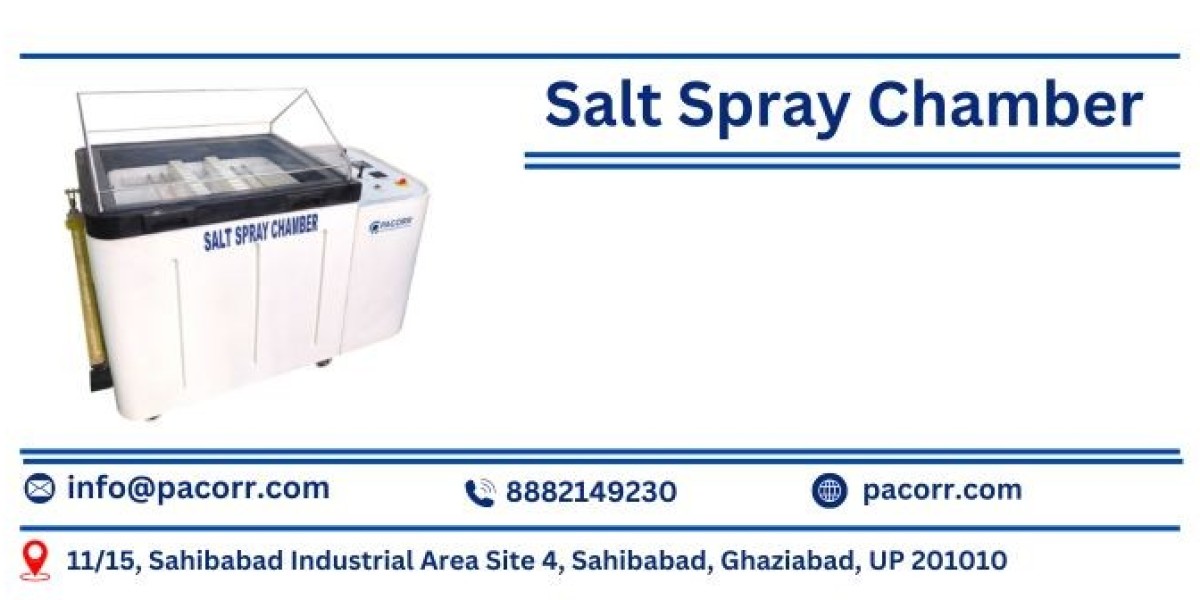Importance of Corrosion Testing
Corrosion can cause extensive damage to materials, leading to structural failures, safety hazards, and increased maintenance costs. Corrosion testing is essential for industries that operate in harsh environments, including marine, automotive, aerospace, and construction. The Salt Spray Test Chamber provides a controlled environment to accelerate the corrosion process, enabling manufacturers to predict how materials will perform over time.
How the Salt Spray Chamber Works
The Salt Spray Chamber simulates corrosive conditions to evaluate the durability of materials. The test involves exposing samples to a fine mist of saltwater solution, replicating the effects of saline environments. Here’s a breakdown of the testing process:
- Preparation of the Salt Solution: A standard solution, typically 5% sodium chloride (NaCl) in distilled water, is prepared to create the saline environment.
- Placement of Test Samples: Samples are arranged inside the chamber on racks or holders. They are positioned at an angle to ensure even exposure to the salt mist.
- Atomization of Salt Solution: The solution is atomized using nozzles, creating a fine mist that settles on the samples. The chamber maintains controlled temperature and humidity to ensure consistent conditions.
- Exposure Duration: Samples are exposed to the mist for a specific period, ranging from hours to weeks, depending on the test requirements. Conditions are monitored throughout the test to maintain accuracy.
- Evaluation of Corrosion: After exposure, samples are inspected for signs of corrosion, such as rust, pitting, or blistering. The extent and severity of these signs indicate the material's resistance to corrosion.
Applications of the Salt Spray Chamber
The Corrosion Test Chamber is utilized across various industries to test the corrosion resistance of materials and coatings:
- Automotive Industry: Evaluates the corrosion resistance of car bodies, chassis, and components, ensuring durability against road salts and environmental exposure.
- Aerospace Industry: Assesses the durability of aircraft parts and coatings to prevent corrosion-related failures in flight-critical components.
- Marine Industry: Tests the resistance of ship hulls, offshore structures, and marine equipment to saline water, ensuring longevity and safety.
- Electronics: Evaluates the corrosion resistance of electronic components and enclosures, ensuring reliability in humid and salty environments.
- Construction: Ensures the durability of building materials and coatings exposed to coastal or industrial environments, preventing structural degradation.
Benefits of Using the Salt Spray Chamber
The Salt Spray Chamber Price offers several advantages for manufacturers and researchers:
- Accelerated Testing: The chamber provides an accelerated environment to quickly evaluate material performance, allowing for faster development cycles.
- Consistency and Reproducibility: Controlled testing conditions ensure consistent and reproducible results, facilitating reliable comparisons between materials.
- Cost-Effectiveness: Early identification of corrosion issues allows manufacturers to make informed decisions, reducing the risk of costly failures and recalls.
- Compliance with Standards: The Salt Spray Chamber helps manufacturers adhere to industry standards, such as ASTM B117 and ISO 9227, ensuring product reliability and market acceptance.
Conclusion
The Salt Spray Chamber is an essential tool for evaluating the corrosion resistance of materials and coatings. By simulating harsh environmental conditions, it provides valuable insights into material performance, helping industries enhance product quality and durability. As the demand for corrosion-resistant products grows, the Salt Spray Chamber remains a cornerstone of testing technology, driving innovation and reliability across various sectors.
For more information about the Salt Spray Chamber and its applications, visit Pacorr Testing Instruments.
FAQ: Salt Spray Chamber
What is a Salt Spray Chamber?
A Salt Spray Chamber, also known as a Salt Fog or Salt Mist Chamber, is a device used to test the corrosion resistance of materials by exposing them to a mist of saltwater solution.
Why is corrosion testing important?
Corrosion testing helps determine how materials will withstand harsh environments, ensuring product durability, safety, and longevity.
How does a Salt Spray Chamber work?
The chamber generates a fine mist of saltwater that settles on test samples. The samples are exposed for a specified duration and then evaluated for signs of corrosion like rust or pitting.
What materials can be tested?
Metals, coatings, plastics, and electronic components are commonly tested in a Salt Spray Test Chamber.
How long does a test last?
Test durations vary but typically range from a few hours to several weeks, depending on the requirements.
What standards apply to salt spray testing?
Key standards include ASTM B117, ISO 9227, and JIS Z 2371, which outline procedures for salt spray testing.
What are the benefits of using a Salt Spray Chamber?
- Accelerated Testing: Quickly evaluates material performance.
- Consistency: Provides reliable and repeatable results.
- Cost-Effective: Identifies potential issues early.
- Compliance: Meets industry standards.
How are results evaluated?
Samples are inspected for corrosion signs such as rust, pitting, or blistering to assess their resistance.
Which industries benefit from salt spray testing?
Industries such as automotive, aerospace, marine, electronics, and construction use Corrosion Test Chamber to ensure product durability in corrosive environments.
Where can I get more information or purchase a Salt Spray Chamber?
For more information or to purchase, visit Pacorr Testing Instruments.



